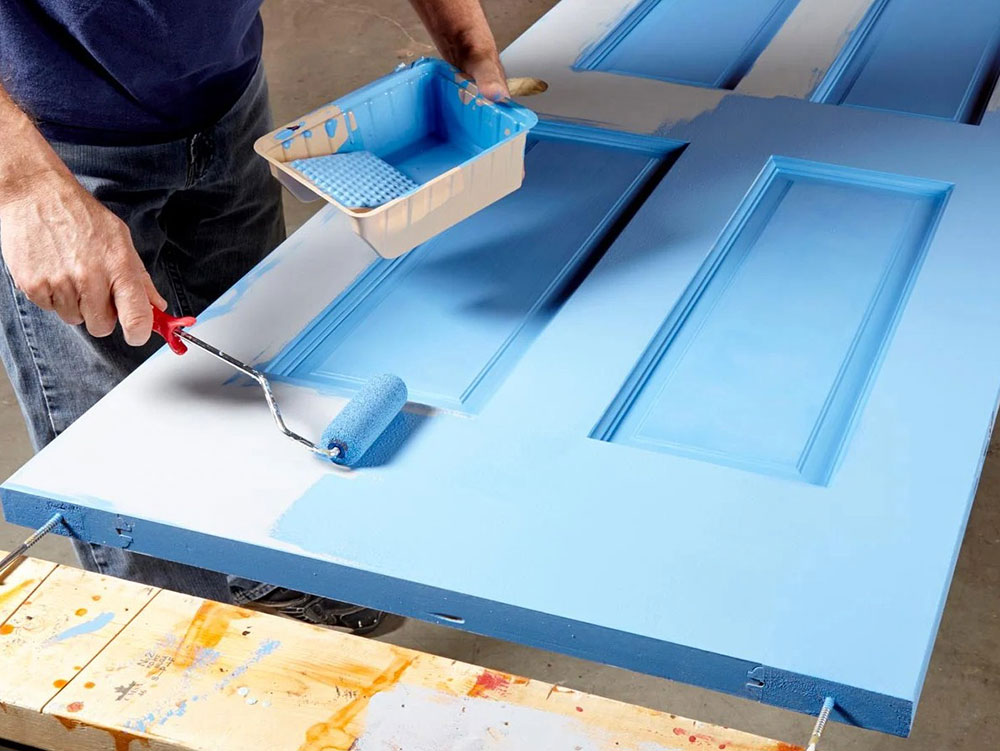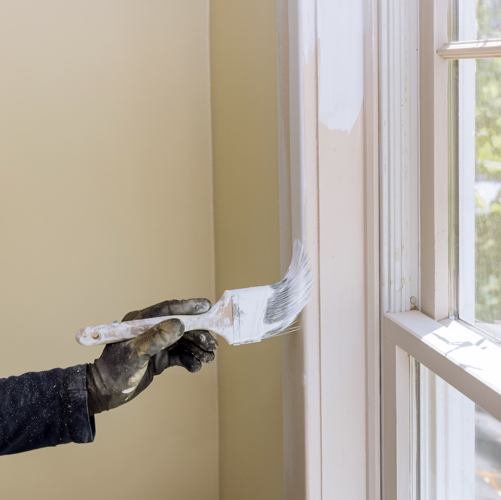Can you put oil based paint over latex
Painting is a process that can be used and reused in as many possible ways as the imagination allows. Almost everything is painted. We, humans, are organisms that adore the colour. This is perhaps the reason that not only do we paint our items of daily usage so meticulously. But also keep on renovating and rejuvenating them.
Adding colours is also decoration and, most importantly, art. This is why mixing and merging different types of paints to create, renovate or replicate art is always used among enthusiasts.
But can you really use oil-based paint over latex-based paint? To answer this question, we first need to understand how oil based paints and latex-based paints interact with the surfaces and each other.

What is oil-based paint?
Oil-based paints are made up of oil or chemical solvents. These paints are more durable and resistant to environmental factors than the latex variations. Oil-based paint on your daily use products can mean that they will last twice or thrice as long as a latex-based paint job.
There are great quality oil-based paint variations for almost every product out there. Using oil-based paint to paint your surface does take extra initial work. And that is needed in terms of preparation of both the surface and the paint. However, since the result is much better, this hassle becomes worth it.
You need to remember one thing when it comes to canvas paintings and decorations. That painting styles with latex or water-based colours are distinctly different from the painting styles of oil-based ones. This does not mean that you cannot use oil-based paint on top of watercolour.
However, the effect will vary greatly and look like a completely different picture. One more thing to remember about canvas paintings and decorations. Without proper preparation before applying oil-based paint on latex, unnatural pigmentation might occur on the surface.
What is latex-based paint?
Latex paint is usually always the more preferred didn’t opt in general cases. This is because they are easy to use and can be experimented with by a beginner to achieve clean results.
Latest-based paints are usually also completely non-toxic. They dry quickly and cure within 48 hours to 3 days.
On average, latex-based paints wear down much more quickly than oil-based paints. This, however, does not mean that latex-based paints are not durable.
You will remember that acrylic paint is also considered a latex-based paint. And these paint types are widely regarded as the most versatile and long-lasting paint medium options. i have written the difference between latex paint and acrylics and shared over this post for your better understanding.
In cases where canvas paintings and decorations are concerned, it is better to renovate the piece of art with a new latex-based paint job instead of switching to oil.
However, where furniture walls and items of everyday household use are being considered, you should definitely add an extra buffer system of protection to these items through an oil-based paint job.
Why should you paint oil-based paints over latex paint jobs?
In which cases is it a good idea to switch the painting medium while giving your item of choice a paint renovation or upgradation? Let us discuss some popular situations in which people paint oil-based paint over latex ones.
On walls exposed to the outer environment
The walls and fences on the outer side should always be painted using oil-based paints. This is due to the simple property of oil-based paints being able to withstand harsh conditions longer.
Oil-based paints are held together strongly and protected by an outer coating of environment-resistant oil. Instead of letting dirt dull its colour, oil paint uses dirt on its surface. Why? For better layers of protection as time passes.
Walls exposed to oils and dirt
In relation to what we said just now, it should be remembered that latex-based paints do not work well with regions of great oil or dirt production. Walls around your work desk that have the highest chances of observing smudge perform better when oil-based paints are added instead.
In kitchens and areas surrounding chimneys or fireplaces, oil-based paint is preferred. Oil-based paints do not readily absorb smudges or dirt. This means that after years and years of usage, oil-based paints will be easier to clean off when the surface inevitably gets dirty without damaging the top layer.
Places of high friction
Places that undergo hi frictional activity daily, like doors and trims, need oil-based paint. Like moisture and dirt, oil-based paint has this outer layer of oil protection, saving it from frictional damage for quite some time.
This is why many objects of everyday use like cups and vases are often painted with oil-based paints at the bottom, if not the whole product itself. Other areas of high friction will include your desk or chair if you intend to paint them, cupboard or closet doors, walls around your gym room, etc.
On furniture placed out of doors
Just like with walls and fences, furniture placed out of doors can largely benefit from an oil-based paint job. Hence just like with voice and fences, you can renovate your old outdoor furniture by giving them an oil-based paint job.
Having discussed before that oil-based paints are resistant to the environment, we know that they protect the vibrancy and existence of the colour itself and the surface underneath it. This means you are increasing the longevity of your products by painting them with oil-based paint.
On furnishings that come in close contact with water
We mentioned in passing before that oil-based paints perform well around moisture. In truth, it can be argued that oil-based paint is completely resistant to moisture, as a layer of oil between the moisture and the pigment acts as a barrier between their interaction.
When you have products or furnishings in your kitchen and bathroom which you wish to continue to use without ruining their long-term vibrance, you should always try to give them an oil-based paint job.
Products that will undergo heavy use
Since oil-based paint is resistant to moisture, dirt, environmental factors, and even friction, naturally, it should be chosen for products that will undergo heavy use. If you are a creator intending to upgrade vintage items for the modern individual, the reality is you will require help from the oil-based paint canister.
Even general articles which you know will find their place in the kitchen, bathroom, or desk can be intentionally painted with an oil-based paint for a longer existence.
To give them that characteristic shine
Oil-based paints have a characteristic shine and glow that latex-based paints are simply not meant to have. Just like with human bodies, this glow comes from the existence of the right amount of oils on the painted surface.
If you want a pre-existing product or object to gain the aesthetic quality of an oil-based paint job, then undertaking this project will make perfect sense. Oil-based paints are also very vibrant.
To restore the condition
Restoring the condition of vintage or worn-out products involves both technical and aesthetic decisions. The oil-based paint has the right qualities. Combined with other restoration materials, including plasters and sandpaper, they make for the perfect cycling toolkit.
Importantly, if you are working with old wooden furniture and would like something with a bit more contemporary surprise against the plain old polish, a good shade of neutral oil-based paint will be your lifesaver.

How can you paint oil-based paints over latex paints?
It is time to learn and analyze the process of using oil-based paints over latex. Usually, for oil-based paint to be applied over latex paint and to still stick to the surface, the most important step is the correct preparation of the surface. Without the correct preparation, the paint will simply not stick. It is this preparation that we will be discussing now.
Sanding the surface
The sanding process is the most important part of repenting a latex paint surface with oil-based paint. Sending the surface will remove all the stickiness of the top layer of paint and increase the surface’s texture for the new paint to hold on to. This will enable new paint to last longer on your wall or furniture.
Levelling the surface with fine-grit sandpaper
A two-level sanding process is crucial for oil-based paints being applied over latex paints. After you have cleared out the top greasy layer of latex paint, it is time to use fine grit sandpaper to level down the surface to absolute uniformity.
Clean it with a wet cloth
Even after you have sanded down the paint, you still have to clean. Use a wet cloth or mop to clean the dirt and paint particles that have stuck around on your walls as a part of the sanding process. After you have done this, inspect your wall or furniture carefully to see if there is something you have missed.
Mask the surrounding area
Depending on what kind of paint you are using and on which surface you might need to mask the surrounding area. If you are planning to use more than one type of paint, it is a good idea to mask the boundaries of each painting with a masking step so that you do not colour over the lines. Mask the doors, door frames, window frames, and trim for wall painting. For furniture, painting makes sure not to apply paint on metal handles, etc.
Use proper primer
A great quality oil paint primer has an opaque property of its own. It can completely cover the original layer of latex paint and will work very well. A good primer is the first and major saviour of this project. Without a good primer, your oil-based paint will reveal its latex history. Apply two coats of primer and allow it to dry out completely before starting the painting process. to know if your oil based primer works with latex paint this post explains it all in detail.
Time to paint
It is now time to bring out the creative artist in you and get along with the actual painting process. Don’t be afraid to give into your crazy ideas and have a lot of fun. Apply double coats of paint if required, and pay special attention to areas that show a different colour. Keep going back to those areas until it is perfectly done.
Oil-based sealant
Usually, the varnish is not used with the wall painting. However, if you are painting furniture or other products, a good sealant is a necessary finishing step to ensure the longevity of your item. Especially if you intend to use these products out of doors or are convinced your customer will do so, do not skip out on the varnishing step.
Mistakes to avoid while painting oil-based paint over latex paint
- Always preceded the painting session with two steps of sandpapering.
- Never use standard latex primer before using oil-based paint
- Do not forget to add finishing after the masking tape is removed carefully
- Wear protective gear before handling oil-based primer and paint as they can be toxic.
- While your painted item or walls are drying and curing, keep them away from the atmosphere in which you and your loved ones live.

Conclusion
Undertaking an oil-based paint job over latex paint can save many projects, new and old. The process is pretty standard and can be done by anyone within a day.
While working with sandpaper and oil-based paints, which are chemically toxic, never forget your protective gear. Always use a face mask, gloves, a prince and other necessary equipment to keep your skin, lungs and hair safe from the oil-based paint. if you want to know more about oil painting job on glass items then read this guide for best results in the end of your paint job.
FAQs
Is it possible to apply latex paint over oil-based paint?
Yes, going the other way around is also possible. You can use the correct preparation process to paint latex over oil-based paint.
Can you apply light-colour oil-based paint on dark colour latex paint?
By using a strong and opaque oil primer, you can apply light-coloured oil-based paint on dark-coloured latex paint. At most, you might see that one coat of light paint is not enough, so you might apply double coats.
What kind of primer should we use before oil-based painting?
There are specially designed primers in the market for oil-based or chemical solvent-based paints.

Being associated with art and craft field since decades as a hobbyist and life long learner has given me an opportunity to learn many new things related to art, craft, paints and pottery which i am trying to share with your guys on this website. I have expertise of being professional painter and potter for the last 20+ years
I have learned mind blowing cool tips and insights which makes me a person with ability to improvise and come up with creative ideas and solutions to make stunning and impeccable art pieces of all types which are adored by people across the globe on this website and other platform.


